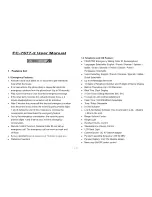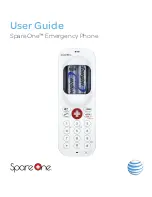
Copyright 2010-2015 Obihai Technology, Inc.
166
rb = Ringback Tone
ro = Reorder Tone (same as fast busy)
si1 – si4 = SIT TONE 1 – 4, respectively
st = Stutter Tone
0 – 9, *, #, a – d = DTMF 0 – 9, *, #, A – D respectively
Change Interdigit Long Timer Dynamically After Partial Match
The OBi starts off with the interdigit long timer set to the configured
DigitMapLongTimer
value when processing a
new digit sequence by a digit map. You may change the long timer as some patterns are partially matched by
embedding the syntax {L=<
time
>} within a rule in the digit map, where <
time
> is the desired number of seconds for the
long timer.
For example:
(011 853 xxxx xxxx{L=5}x. |xx.)
. Here the long timer is shortened to 5s after the user has
entered 011 853 + 8 digits. Hence the OBi will declare that a complete number is collected in 5s when no more digits
are received. Without the {L=5} syntax the user will have to wait for 10s (by default) for the same to happen.
User Defined Digit Maps
There are 10 user definable digit maps available under the
User Settings – User Defined Digit Maps
section of the
device configuration web page. These digit maps are referred to as User Defined Digit Map 1 to 10. Each user defined
digit map is specified with 2 parameters:
-
Label
: An arbitrary string for referencing this digit map in other digit map specification. The value should be
2-16 characters long. For example, “friends”. In this case,
(Mfriends)
can be referenced in other digit maps,
such as
Phone Settings
::
DigitMap
-
DigitMap
By default both parameters are empty, except for User Defined Digit Map 1 (see the section below).
A User Defined Digit Map For IPv4 Dialing
The default values of the parameters for User Defined Digit Map 1 are set the following values to support IPv4 Dialing:
Label
=
ipd
Digit Map
= (xx.<*:@>xx?x?<*:.>xx?x?<*:.>xx?x?<*:.>xx?x?|
xx.<*:@>xx?x?<*:.>xx?x?<*:.>xx?x?<*:.>xx?x?<*::>xx?x?x?x?)
The map (Mipd) is referenced in the default setting of the
DigitMap
in ITSP Profile A and B. It supports the following
two forms of IPv4 dialing:
a)
<user-id>*<a>*<b>*<c>*<d>
b)
<user-id>*<a>*<b>*<c>*<d>*<port>
Where <user-id> is an arbitrary length numeric user-id, such as 100345, <port> is a port number in the range 0–65535,
and each of <a>,<b>,<c>,<d> is a 1-3 digit pattern in the range 1–255 that identifies one byte of an IP address. The
dialed number will be translated into <user-id>@<a>.<b>.<c>.<d> and <user-id>@<a>.<b>.<c>.<d>:<port> respectively.
Here are some examples:
1234*192*168*15*113
maps to [email protected]
123456*192*168*15*180*5061
maps to [email protected]:5061
















































